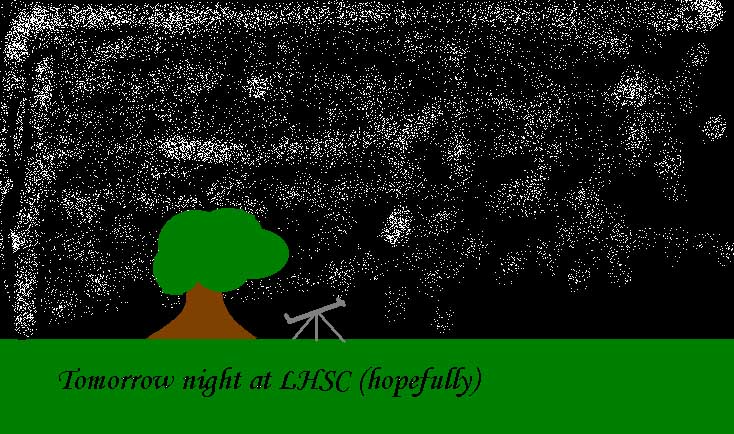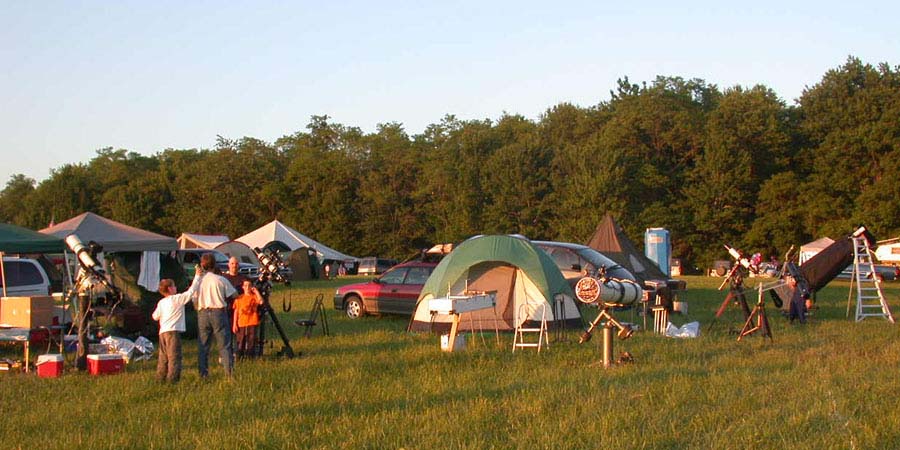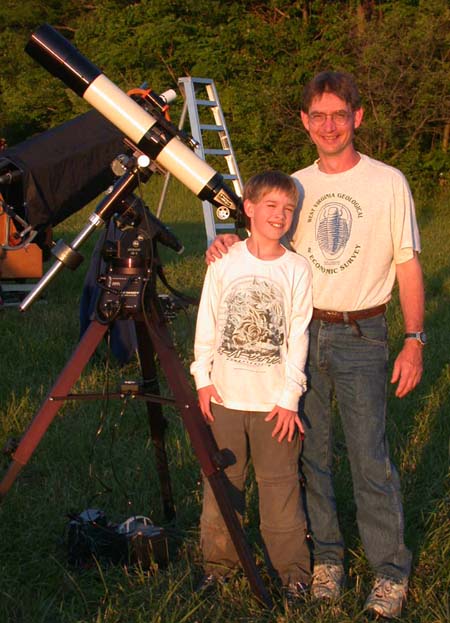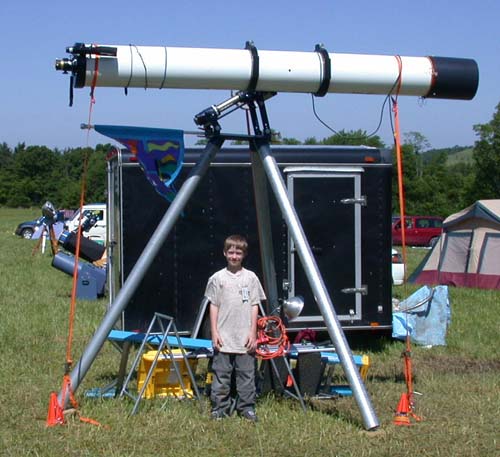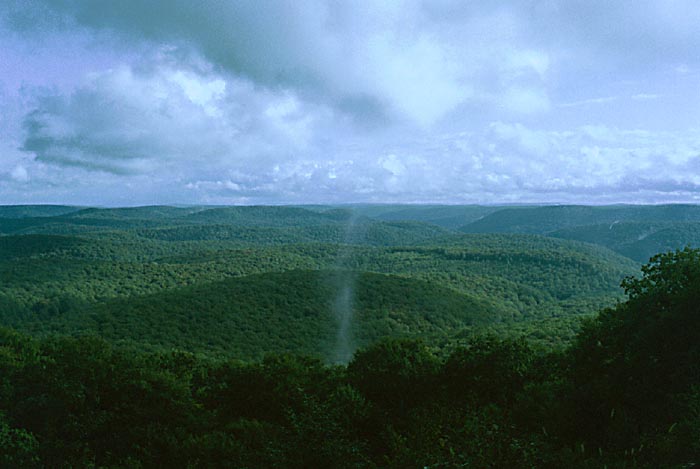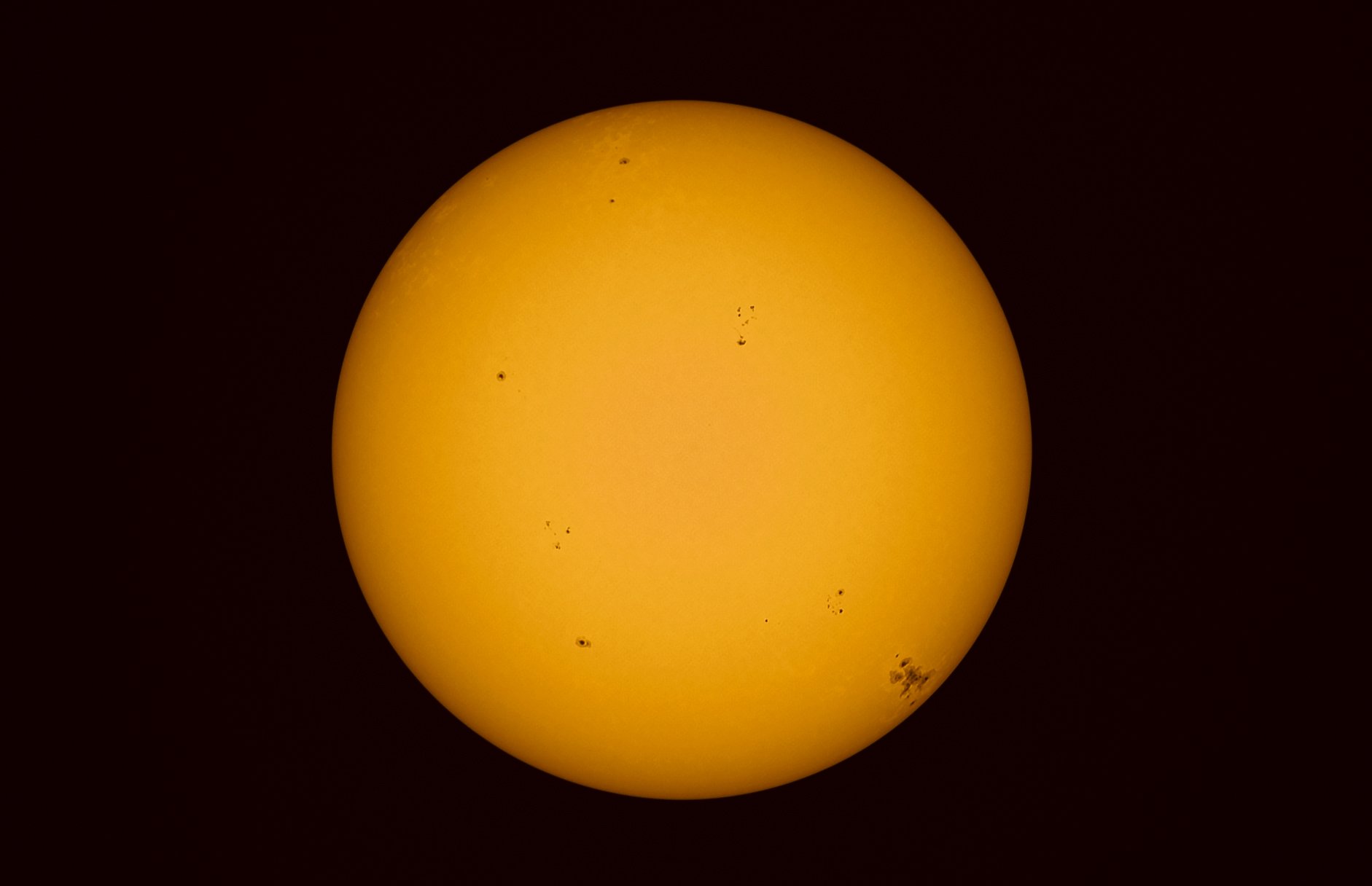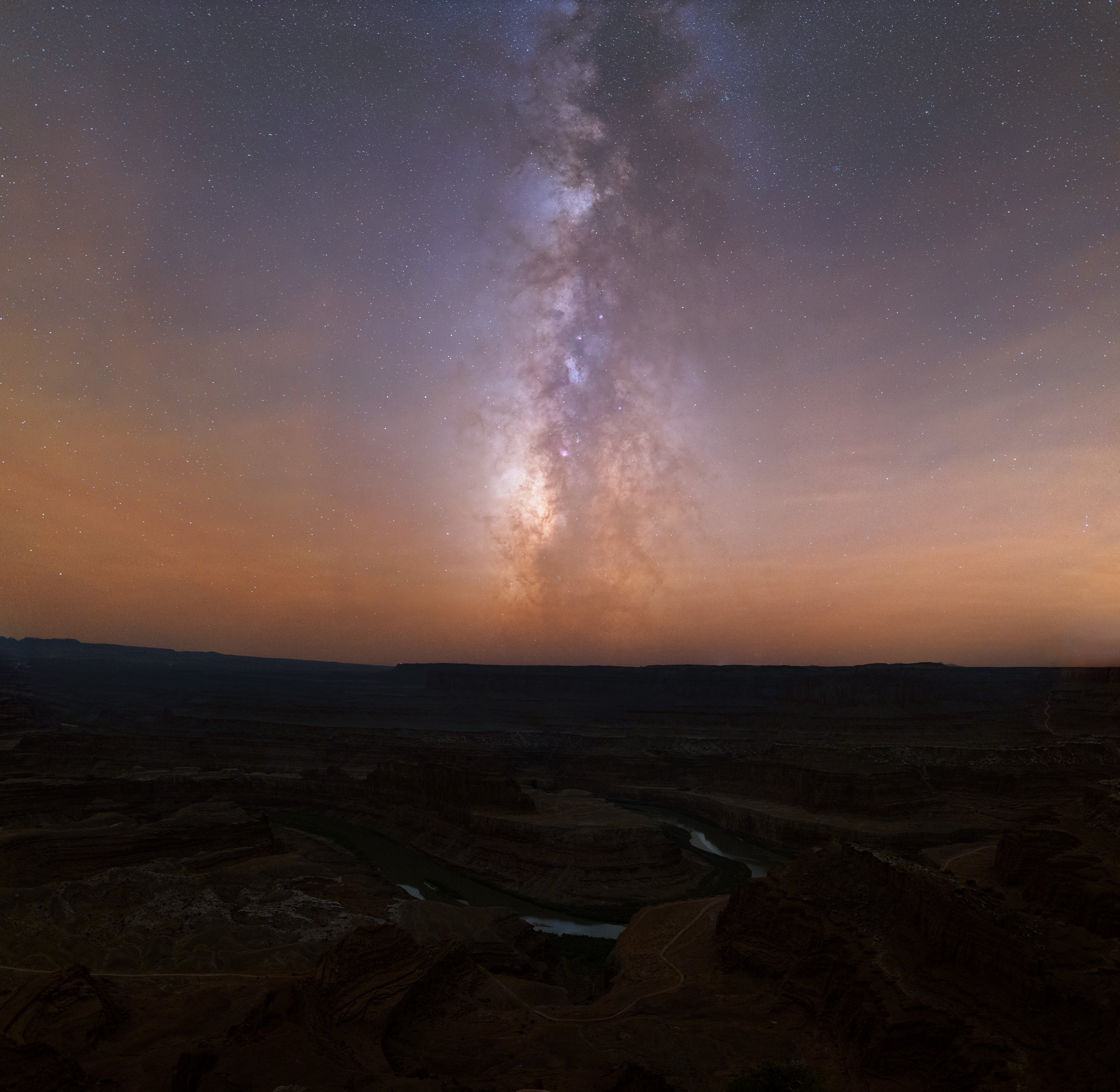Laurel Highlands Star Cruise 2002
Artwork by Chris Oyster on Thursday night during the heavy rain. His hopes were realized over the next two nights!
Turn to the Dark Side, my young apprentice
(a.k.a.) The Laurel Highlands Star Cruise
June 6-9, 2002
Opinion paragraph first<g>
I have never seen a harder working starparty crew than the one at Laurel Highlands Star Party. Terry Trees, Larry McHenry, Ed Moss, John Holtz, and many others have developed this event into a premier week-long starparty. They are not content with the current status. They are continually seeking out ideas and suggestions for improving the event. This year, there were many competing starparty events. I have not attended the New Jersey event, but I have attended the Mason Dixon event. If you want dark skies and a starparty, it seems to me that Laurel Highlands is your best bet for the spring in the east. Formal presentations began on Wednesday and concluded on Saturday. Observing began as early as Monday. Many of these activities are children events. I don't believe any event in the east offers programming to that extent. Perhaps the Winter Star Party. Is it a perfect sky? No. There is a light dome to the northwest from Uniontown. It is summer, who cares about the northwest? The summer Milky Way was breathtaking. You can read my observation report below for more details. Granted, Spruce Knob has a better total sky, but if you are wanting to combine a great weekend of observing/photography at a DARK site with a group of amateurs who share your passion for astronomy, Laurel Highlands Star Cruise serves as the standard to beat in the east coast for the spring/summer season. Black Forest is the place to be in the east for the fall schedule of starparties.
Camp:
The OVAS campsite on Saturday night
Observing/Astrophotography equipment in the camp: 20" Obsession, TV102, 10" Cave Astrola, AP 130EDT, TV101, 4" reflector, TV85, Fuji 7x50.
WE WON, again: Our winnings weren't as big as last year, but our camp did well with respect to door prizes. Chris O won the Orion case, Dave T won the planisphere, and I won the set of Night Sky Observer's guide. I can't express how useful this book is to astrophotographers.
Justin (left) and Rodger Blake with their 20" Obsession. Outstanding views were had with this instrument!
Best Views: during my imaging sessions I get to sneak wonderful views from others. Thanks a bunch to all who shared wonderful views!
- Marla, Dave, and Evan Tolley with the TV101 ready for some prime focus photography
The Site: Pine Hill campground near Bruceton Mills, WV
Pine Hill is located about 10 minutes off of I-68 which runs just below the Mason-Dixon line. The elevation at the site is around 2,200 feet. It is a beautiful forested area with Morgantown the nearest city of consequence about 30 miles to the west.
Limiting Magnitude- Sky background flux of 70: Now that I have begun imaging with CCD, I can utilize technology in quantifying our sky conditions at Laurel Highlands. I took background measurements on Saturday night. Friday night was a little more transparent, but turbulent conditions prohibited imaging with CCD. Here is a link to the mathematical calculations and theory behind the technique. A special thanks to Stan Moore for making the webpage available!
http://home.earthlink.net/~stanleymm/StandardBackground.html
The numbers according to my camera (ST10e) have a background flux of 70. That seems to compare very favorably with some of the darker imaging sites in the California mountain ranges.
Light domes: There is one noticeable light dome to the north-northwest that is from the Uniontown area. It rises no more than 15 degrees above the horizon and was not significant in any way. 75% of the sky is excellent. The southern sky is gorgeous.
Chris and Larry Oyster with the TV102. Larry observed some very dim objects courtesy of the outstanding skies at Laurel Highlands
Laurel Highlands Star Cruise: The Event
The field: The observing field is quite large and has plenty of room for more participants. It provides excellent horizons. There is no electricity on the field, however. The bathhouses are located in the main camping area, which is about .3 miles away. It is a nice walk or a short drive. The bathhouses are comfortable and convenient. The field can accommodate large RV’s. The organizers sectioned off the entire field with observing spaces that were quite large. This really added structure to the field and provided defined areas for foot and vehicular traffic. The heavy rains on Thursday really created a mud-bog on Friday. The hot Sun and gentle wind dried the field much quicker than I ever would have expected. I feared that the ground moisture was going to lead to ground fog on Friday night. The sky could not have been clearer on Friday night. We were very relieved.
Chris Oyster presents his 4" reflector to the group touring unique telescopes. This is a reflector of unknown make that has been refurbished and painted and gave some pretty nice views.
Don Kemper relaxing at the rocket launches
Food was catered by a local deli shop. The food was prepared off-site and brought to the campground. Mealtimes were relatively fixed. Snacks were available until around 11:00 p.m. The food was very good. Not as convenient as having May's around at all hours of the night, but I certainly did not go "without" when it came to food. Very nice caterer and I am sure they learned a lot about planning food for a starparty.
Rodger Blake and the OVAS crew "man" rocket launch pad #6 on Saturday
The door prizes just keep getting better. Two telescopes and a 16mm Nagler type 5 were the big ones I remember. I did win the prize I wanted most, the Night Sky Observers Guide. The Pittsburgh group continues to build this event. I believe the event attendance was a little under 300. Please see their website for future dates. I believe they have moved from the new Moon date on Memorial weekend next year to later in June. This works well for me-I get to go to New Mexico skies for Memorial Weekend next year!
Chris Oyster under a brand new D&G 10" refractor. Cool, huh?
Chiefland Astro-Photo trip 2002
Manatee surface for air at Manatee Springs State park, nearby to Chiefland Astronomy Village.
The astrophotography trip was a great time of fellowship with friends. Unfortunately, the days were beautiful and the nights were not. Nightfall always seemed to bring in some haze/clouds. The clouds would drift in from all directions. It was a very frustrating trip. Next year-Arizona!!!
Fun and frolic at Manatee Springs. The water was very clear at the mouth of the spring.
A big 'thanks" to my father-in-law, a.k.a. the papinator. With no astronomical interest, he accompanied me on the trip to beautiful Chiefland, FL. He got to know the folks at Wal-Mart quite well:-)
Kirk Rogers made the trek from Maine. Kirk has the AP130/TakFS 102 and numerous camera bodies on the MI250 mount.
George Whitney accompanied Kirk from Maine. It looks like he knows what he is doing, but he really doesn't:-)
Warren Keller..he's our feller. The New Jersey native headed south for some astrophotography with his Mak-Cass and Nikon 300mm lens. He caught some very nice shots considering the conditions.
Black Forest Star Party 2001
Black Forest Star Party 2001 (extended)
Sept. 12-17-2001
The Central Pennsylvania Observers hosted the BFSP 2001. Attendance was listed at around 400! Weather was great on 4 out of 5 nights. What a great trip! Everything was there for both visual and astro-imager. Here are some of my memories of the week.
- CSSP is an outstanding dark sky location.
- The new showers at Ole Bull State Park (about 20 minutes away) are awesome. I thought I would never say that a $2 shower was worth it, but Ole Bull is. Lyman Run is building showers, so the drive will be even shorter soon.
- Keynote speech by Ed Ting was just right in content and tone - Thanks Mr. Ting.
- Just about all equipment you could want to see was there.
- Could not meet a nicer group of people in attendance
For more details on the event and site see the official website at http://www.bfsp.org/starparty/
The Site: Cherry Springs State Park
The drive up from the south of CSSP affords this beautiful scenic view. The state park is in the Susquehannock state forest. It truly is a beautiful place for a star party.
Limiting Visual Magnitude: I personally did not perform a visual limiting magnitude. I heard others estimate some nights in the 6.6-6.7 range. The conditions were just fine for astrophotography:-)
Light domes: Only under the worst conditions can you spot a slight light dome in the area of Coudersport. There are no light domes that impact the site at all.
The field: The observing field is quite large and has a little more room for more participants. It provides excellent horizons. Electricity was available on the field courtesy of the Central Pennsylvania Observers and the local Galeton Rotary club. Thank you!! The growth of the star party is probably leading to the necessity to section off the field for a more efficient use.
I arrived on Wednesday evening and met Nick and Ken, both deep sky observers with beautiful truss dobs. My apologies to the deep sky observers, but for me, this meeting was an imagers dream. There were more imagers in attendance at BFSP 2001 than at any other star party I have attended. I learned a lot of new techniques. Below are some of the imaging setups at BFSP.
I did not get the name of this imager, but his imaging system was very impressive. A C-14 on a Losmandy HGM200 mount with an ST8 camera. The night we visited he had some beautiful raw images of NGC 6946 on his computer monitor.
John Varljen with a great imaging platform: an AP 155 with 4" focuser, AP 1200 GOTO mount, nitrogen purge, ST-4, and Pentax 6x7 camera. I learned many new techniques from John. Thanks!
Anthony Davoli with his Vixen 102 and homemade G-11-type mount. Great craftsmanship on Anthony's part. Thanks Anthony for all of your help with handiwork on site!
Fellow APMLer Warren Keller. It was great meeting Warren. He educated me on the use of the STV and twisted my arm to buy one:-) Thanks Warren. Another great imaging system with the Mak-Cas on GM8, Nikon F2, and STV autoguiding.
Best Views: I thought the best views for transparency and seeing were on Sunday night.
- Binoviewers are awesome. The best views for me were of M13 through Ken's 14.5" Starmaster with a TV Binoviewer. Don't remember the eyepieces, but M13 was spectacularly 3-D.
- Saturn in a Binoviewer. Again, Ken shared a tremendous view of a 3-D Saturn just sitting out there in space revealing all of its intricate details. Thanks Ken.
- Most intriguing view was shared by Gary Honis of an extra-galactic globular cluster associated with the Andromeda Galaxy. I believe the designation was Mayall or G-1. It was an observing challenge for me, but very cool.
- Dave Barrett always has the greatest views through his 24" Tectron. In addition to the Horsehead views, his views of Saturn on Sunday morning were simply awesome. My little 5" AP had some pretty nice views of Saturn as well:-)
- Nick helped us frame a photo object by showing us the Elephant trunk in IC1396.
- Gary Honis shared a great view of NGC 253 were dark lanes were very obvious.
- We had some tremendous daytime solar observing as well through Fran's 6" refractor and my TV85/SolarMax. Several flares were noted, prominences were changing rapidly, and sunspot rotations were noted during the course of 5 days.
- After this event, Cherry Springs reputation has only grown as being a great gathering place for observers and imagers. The Central Pennsylvania Observers did a tremendous job, especially considering the tragic events earlier in the week. BFSP is definitely a priority event on my schedule. I only hope to be able to get to CSSP more often than once a year. Clear skies!
Black Forest Star Party 2000
Cherry Springs - Blackforest Star Party 2000
The weather was not very cooperative for the 2000 BFSP. Nonetheless, we met some great folks, watched some movies, and saw some great equipment. It was obvious from the darkness of the sky on the cloud layer that conditions can be very nice at Cherry Springs. Here is the link to the Blackforest Star party. Here is another link to Cherry Springs that is posted by Tom Bemus.
Well, here is camp at Cherry Springs. New tent and new awning served us nicely.
Tom Bemus is a major promoter of Cherry Springs. Here, he shares views through an AP Stowaway.
Part of the observing field at Blackforest.
Winter Star Party 2001
The following is a repost in an attempt to preserve some of my astronomical history. Hope you enjoy this step back in time.
The Cry:
The winter of 2000 was – well – cold! We had 15 days of temperatures below freezing. That is just too cold for me. Frustrated, I went to the net for help. I posted the message below to the Astro-photography mailing list on January 19, 2001.
Hey APML,
Well, I have officially had it (too much winter for me already)! I am
planning a trip to Chiefland, FL < http://www.c-av.com/ > for the Feb. new
Moon period starting around Feb. 21. Anyone want to get together down
there? If so, please reply to my email below so we can make plans off
line. I will be driving down from West Virginia. I have never been there,
so it will be all new to me.
I got a response! Kirk Rogers, from Maine, was going to the Winter Star Party in West Summerland Key, FL. He said he may have an extra ticket and asked if I was interested in it. The Keys were a little further south than I had originally planned for my trip. I would now have to take a full week of vacation rather than 2-3 days. Why not? Let’s go. I got a ticket and planned on meeting Kirk at the WSP.
The Skies:
The WSP is located between Marathon and Key West on West Summerland Key. It is held at the Camp Wasumkee Girl Scout camp. There are significant light domes from Key West and Marathon to the west-northwest and east-northeast, respectively. The southern view is quite nice and isn’t that what we are here for anyway? The following conditions were recorded for each night:
I would probably rate WSP skies as a Class 4 on the Bortle Dark Sky scale. The clouds to the south are not illuminated at all. If you just concentrate on southern objects to the zenith you will find the skies quite useful. I never looked at any deep sky objects 20 degrees north.
The People:
Rick Singmaster, Al Nagler, Tom Back, Markus Ludes, Jim Kendrick, Tom Clark, Mike Peoples and others.
On Tuesday evening, a man and woman were walking around the campsites in stealth mode. It was Al Nagler and his wife. In retrospect, I believe Al was mapping out the location of all of the Televue scopes to return at another time for some field-testing. This night Al pointed my TV 85 to M46 / M47 to share the view with his wife. Later that night I moved my scope for a look at the Pleiades and saw horrific green colored stars. Oops! I had forgot that I left my Orion Ultrablock filter on my 22 Type 4 Nagler from the previous night while viewing Eta Carina. I told Al the story the next day and he had a chuckle and thought the view of M46/M47 was a bit dim.
I had a very pleasant dinner conversation with Tom Clark and his wife one evening. He extended an invitation for us to visit Chiefland sometime. I hooked up with some friends from the Carolinas and we stopped at Chiefland for a night on our return trip home. Conditions that night were heavy dew with ground fog. We slept on the picnic benches (first for me). I hope to return for an extended stay at Chiefland sometime in the future.
I also made some great new friends. Kirk Rogers and George Whitney setup in camp with me. They are great guys who are very knowledgeable about astronomy and photography. They have great equipment to look through, too. While I was taking pictures, Kirk and George let me play around with their LX200's. Pretty nice, huh?
Hideaki Kimura, David Connor, and Paul Titus are new astronomy friends after WSP. We observed together and drove to Chiefland on Saturday together. I look forward to meeting up with them at future star parties.
WSP was also a chance for me to hook up with fellow astrophotography Joe Morris. Joe had spent the previous week at Chiefland doing some AP. He is a fabulous imager and I hope to work with him on other trips for astrophotography in the future.
The Scopes:
Markus Ludes shares views through the 8" TMB with Coronado H-Alpha filter.
I can’t think of too many scopes that weren’t there. I did not see any large Takahashi refractors (5" or larger). I saw all Astro-physics except for a Stowaway and the Mak-Cass. Markus Ludes had 4 TMB’s on the field – 105 f6.2, 105 f8, 152 f8(?), and 180 f9. The Starmaster dobsonian dominated the observing field. I estimated the Starmaster to Obsession ratio was 6-1. The 36" yard scope was present. There were some TEC Maks on the field. A couple of 13" Coulter's. Takahashi Epsilon 130's. All TeleVue's. Just about any type or brand of scope you could hope for was there.
This observer was sharing tremendous daytime views of Venus through his 7" AP refractor.
The Observing:
One of the highlights was observing the Sun through Coronado solar filters. The view through the TV 102 and Coronado were simply awesome. Al Nagler commented that these were the best solar views he had ever seen. Markus had the TMB 8" setup with a Coronado and binoviewer. I did not get to look through this setup. The lines were quite long at times. I heard the views were outstanding.
I was extremely happy with the performance of my Kendrick/Baader solar filter on my 130 EDT. Granulation, sunspots, and faculae were very obvious.
The highlights are definitely the planets and Omega Centauri. Al Nagler actually gave me my first view of Omega Centauri in a TV 102. Omega Cen through a big dob is something to behold. It is truly unbelievable. Other objects I viewed through the courtesy of many different scopes and their owners were:
NGC 3268 and 3271- a great pair of galaxies in the same field of view,
Comet McNaught-Hartley, a diffuse glow with no real bright central head,
Centaurus A, spectacular in the large dobs, dark lane with subtle structure very obvious,
Galactic Wanderer - furthest globular cluster in the Milky Way located in Lynx,
Eta Carina, I enjoyed the Fujinon 16x70 views of this the most,
Jewel Box, small but colorful cluster,
Gum 17, a nebulosity patch that is part of the Vela Supernova remnant. I tried to photograph this object- captured the nebulosity, focus is good, but field rotation with 90 minute exposure.
The seeing is so good, my TV 85 easily split the 1.4 arc second double of Eta Orionis.
The Mounts:
I caught my first glimpse of the Yang GT-One mount. It looked a little different from the website pictures. The controls were not on the side of the mount head. I never had a chance to check out the mount performance. I also had a chance to see the MI-250 mount with a C-14 riding on top. A new high-capacity mount was being demonstrated at the vendor table. The mount is made by Wide Sky Optics and is the Millennium Mount. I believe Pocono will be a retailer in the US for the mount. Website is < http://www.millenniummount.com/ > There were many AP mounts. Some of the older 800 and 1200. A few GTOs. I saw at least one Takahashi EM200.
The Presentations:
I saw 3 terrific presentations at WSP.
R. Scott Ireland presented a digitized self running program that featured astroimages from his collection as well as some from Herm Perez. The presentation was accompanied by two symphonic selections that set the mood perfectly. This presentation was so popular that he gave an encore performance.
I was told Donald Parker presentations were not to be missed. Unfortunately, his presentation came on the day after an all-night photo session. I was wiped out. I woke up about 12:30 and his presentation was at 1:00 p.m. I showered and decided that eating was my next priority and I would just have to miss the presentation. I get my lunch, sit down, and what is on the TV- Donald Parker's presentation is being transmitted live and direct to the lunch room. There was only one other person in the lunch room with me. It was air conditioned, not crowded, I was eating and watching Donald's talk. I really lucked out on this one. Yes, Donald's presentations are not to be missed. His presentation was on Mars. He presented CCD images of Mars and its unique features and instructed as to how to note these features during visual observations.
Peter Ceravolo presented a personal account of his imaging quest to put together an animated sequence of comet Hyakutake. His dedication to this imaging quest was quite remarkable and worth every moment.
Our Camp:
This was our home for 5 days. George Whitney prepares for CCD imaging of the planets.
In our camp, we had 2 x 10" Meade LX200’s, a Tak FS78, a Ceravolo 6" Mak-Newt, a Tak Sky 90, 2 x AP 130EDT’s, 16x70 Fuji's, 7x50 Fuji's, and one TV 85. We also had a Losmandy G-11 Gemini mount, a GM8, an LX200 on Milburn wedge, a Telepod mount, and an AP 600 QMD mount.
Photo courtesy of Paul Titus-Thanks Paul. It is nice since I double exposed my roll of film:-)
This was my first outing with the Kendrick tent. I positioned the tent as a wind block against the prevailing winds and it served quite nicely in blocking the winds. The tent withstood the 20+mph winds, a fairly heavy rain, and plenty of sun. I am very pleased with the functionality of the Kendrick tent.
Al comes to visit:
Al Nagler returned to our camp on Thursday night. He had the new 9mm Nagler and wanted to give it a try on my TV85. We put it in the scope and checked out Jupiter. Of course, I have never seen Jupiter like this before. The steady skies of West Summerland Key were quite remarkable.
The view through the 9mm Nagler was quite comfortable. The 9mm had very nice eye relief with no blackout spot and a very large field of view. It was as if the image was just sitting there on the front of the glass.
Here is what Markus Ludes posted to the SAA newsgroup regarding the new 9mm Nagler views on my TV85.
From: "Markus Ludes" <apm_telescopes@web.de>
Newsgroups: sci.astro.amateurSent: Thursday, March 01, 2001 11:00 AMSubject: Re: Mystery NaglerSome words about the new 9 mm Nagler from first observing sessions withuncle Al together at WSP.The new 9 mm looks like an 19 mm Panoptik in outer designing and sizes,extremly compact special designed to be more easy used on Binoviewers.AtDaytime you find again the blue fringe at the edge of fieldstop (as motnewstyled TV show up), at nightime it was not a issue.One night at WSP 2001, Al invited me to take a look through his Combo TV 85and new 9 mm Nagler. It was impressive, the stars have been pinpoint to theedge , the look in view have been extremly comfortable. Same eyepiece usedin an Sky 90 showed an nearly not usuable image, off-axis aberrations likein an fast Dob , which confirms that the TV 85 is superior in fieldflattnesagainst the Sky 90.I was intersted to see how this new 9 mm baby compares against my old 9 mm(without rubber) and I was wondering to see that the new 9 mm show up anbetter fieldcorrection than my lovely old 9 mm, which showed not thatperfect edge correction.Of course we asked Al about the price , Al answered it is not fixed, butexpected to be around 4 40~ $ 50 more expensive than the present modellclear skiesMarkus
Al wanted to compare the TV 85 with the nearby Sky 90. We had an assortment of eyepieces and began the comparison on Jupiter. The two scopes were very comparable on Jupiter. Another comparison evolved between the 2.8-mm Takahashi ortho and the 3mm Radian. I believe most observers agreed that the 3mm Radian outperformed the Takahashi on Jupiter in both the TV85 and the Takahashi Sky 90. The 2.8mm was brought to the camp by Markus Ludes. He and Al had a lively discussion on the performance of the eyepieces. I was too busy tending to astro-photography business to catch all of the details.
Al then went to Sirius for the star test. The diffraction ring pattern was as stable as could be hoped for. Al remarked that it was very difficult for him to duplicate the diffraction images at WSP in his testing facility. He was very impressed with the "seeing" conditions that night. The color in the TV85 may have been slightly less than in the Sky 90. Both the TV85 and the Sky 90 had been returned for pinched optics. All in all the TV 85 performed very well and Al was very happy with the performance.
I'm Hooked:
Looking at M42 in shorts in February is awesome. I am hooked on the WSP. My advice is to have some preparation for blocking the wind. If you do, you will dramatically extend your viewing/photography time. The skies due south are quite nice. My astrophotos of southern objects did not come close to reaching the sky fog limit with E200 pushed two stops shooting at F/8 for 90 minutes. The "seeing" conditions were unlike any I have ever seen before. If you want to know how your scope is performing, go to WSP. It is a must for serious planetary observers. The catering service was very dependable and the food quality was very good. We set up camp right on the waterfront. Many setup nearer to the back of the camp. I believe this is to reduce exposure to the wind. I did find the car headlights to be very distracting when I visited observers on the back side of the camp which is right next to highway 1. The presentations were outstanding. The WSP is a great star party and the organizers have much to be proud of. I hope to return in 2002 with my observing buddy and his 20" Obsession:-)
Jeff's Blog
Join me on photography journeys from desert landscapes to deep sky wonders.

